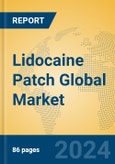The Lidocaine Patch market centers on transdermal delivery systems using lidocaine, a local anesthetic, primarily to manage neuropathic pain such as postherpetic neuralgia (PHN). Introduced in 1999 with the FDA approval of Lidoderm® (5% lidocaine patch) by Teikoku Pharma USA, the market has since expanded with branded and generic variants. These patches offer targeted pain relief with minimal systemic side effects, distinguishing them from oral analgesics. The industry is driven by an aging population, rising chronic pain prevalence, and the shift toward non-opioid pain management amid opioid crisis concerns.
Branded patches like Lidoderm® and Versatis® (approved in Europe in 2007) paved the way, while generics and innovations like ZTlido® (1.8% lidocaine, approved in 2018) have broadened access. In China, lidocaine gel patches entered the national insurance catalog in 2019, boosting adoption. The global market is projected to reach USD 1.0 billion to USD 1.3 billion by 2025, with an estimated CAGR of 8% to 9% through 2030, reflecting steady demand and expanding indications.
This product will be delivered within 1-3 business days.
Branded patches like Lidoderm® and Versatis® (approved in Europe in 2007) paved the way, while generics and innovations like ZTlido® (1.8% lidocaine, approved in 2018) have broadened access. In China, lidocaine gel patches entered the national insurance catalog in 2019, boosting adoption. The global market is projected to reach USD 1.0 billion to USD 1.3 billion by 2025, with an estimated CAGR of 8% to 9% through 2030, reflecting steady demand and expanding indications.
Regional Analysis
North America expects growth of 7% to 9%, with the U.S. leading due to high PHN incidence, robust healthcare infrastructure, and early adoption of lidocaine patches. Europe anticipates growth of 6% to 8%, with the UK, Germany, and France driving demand through aging populations and chronic pain management needs, supported by Versatis® availability. Asia Pacific projects growth of 9% to 11%, led by China’s inclusion of lidocaine patches in its insurance system and Japan’s focus on elderly care, alongside rising awareness in India. South America expects growth of 5% to 7%, with Brazil emerging as a key market due to increasing healthcare access, though cost barriers persist. The Middle East and Africa anticipate growth of 6% to 8%, with the UAE and South Africa leading as healthcare investments grow, though adoption remains uneven.Type Analysis
- Branded Lidocaine Patch: Projected to grow at 6% to 8%, branded patches like Lidoderm® and ZTlido® benefit from established efficacy and physician trust. Trends lean toward innovations improving adhesion and bioavailability, though higher costs limit market share growth.
- Generic Lidocaine Patch: Expected to grow at 9% to 11%, generics dominate due to affordability and widespread availability post-patent expiration. The segment thrives on cost-sensitive markets and increasing competition driving price reductions.
Key Market Players
- Teikoku Pharma: A Japanese company with a U.S. subsidiary, Teikoku Pharma pioneered the market with Lidoderm® and focuses on transdermal technologies.
- Viatris: A U.S.-based global pharmaceutical firm, Viatris offers generic lidocaine patches, leveraging its extensive distribution network.
- Teva Pharmaceutical Industries Limited: An Israeli company, Teva produces affordable generic patches, targeting broad market access.
- Par Pharmaceutical Inc.: A U.S. firm, Par Pharmaceutical supplies generic lidocaine patches, emphasizing cost-effective pain relief solutions.
Porter’s Five Forces Analysis
- Threat of New Entrants: Low to Moderate. Regulatory approvals and manufacturing expertise create barriers, though generic opportunities attract smaller players.
- Threat of Substitutes: Moderate. Oral analgesics and alternative topicals compete, but lidocaine patches’ localized efficacy limits substitution.
- Bargaining Power of Buyers: Moderate to High. Healthcare providers and insurers push for lower costs, especially with generics widely available.
- Bargaining Power of Suppliers: Low. Raw material suppliers face competition, reducing their influence over manufacturers.
- Competitive Rivalry: High. Branded and generic players vie for share through pricing, innovation, and distribution, intensifying market dynamics.
Market Opportunities and Challenges
Opportunities
- Aging Population: Rising elderly demographics globally increase neuropathic pain prevalence, boosting patch demand.
- Non-Opioid Shift: Regulatory and societal moves away from opioids favor topical alternatives like lidocaine patches.
- Emerging Markets: Healthcare expansion in Asia and Africa opens new consumer bases for affordable generics.
- Innovative Formulations: Advances in patch design, such as improved adhesion, enhance patient compliance and market appeal.
- Chronic Pain Awareness: Growing recognition of pain management needs drives adoption in underserved regions.
Challenges
- Regulatory Hurdles: Strict approval processes for new formulations delay market entry and increase costs.
- Price Pressure: Generic competition squeezes margins, challenging profitability for branded players.
- Substitute Therapies: Alternative pain relief options, including nerve blocks, compete for market share.
- Adoption Barriers: Limited awareness and access in developing regions hinder growth potential.
- Side Effect Concerns: Skin irritation or limited efficacy in some patients may deter widespread use.
This product will be delivered within 1-3 business days.
Table of Contents
Chapter 1 Executive SummaryChapter 2 Abbreviation and Acronyms
Chapter 3 Preface
Chapter 4 Market Landscape
Chapter 5 Market Trend Analysis
Chapter 6 Industry Chain Analysis
Chapter 7 Latest Market Dynamics
Chapter 8 Trading Analysis
Chapter 9 Historical and Forecast Lidocaine Patch Market in North America (2020-2030)
Chapter 10 Historical and Forecast Lidocaine Patch Market in South America (2020-2030)
Chapter 11 Historical and Forecast Lidocaine Patch Market in Asia & Pacific (2020-2030)
Chapter 12 Historical and Forecast Lidocaine Patch Market in Europe (2020-2030)
Chapter 13 Historical and Forecast Lidocaine Patch Market in MEA (2020-2030)
Chapter 14 Summary For Global Lidocaine Patch Market (2020-2025)
Chapter 15 Global Lidocaine Patch Market Forecast (2025-2030)
Chapter 16 Analysis of Global Key Vendors
List of Tables and Figures
Companies Mentioned
- Teikoku Pharma
- Viatris
- Teva Pharmaceutical Industries Limited
- Par Pharmaceutical Inc.








